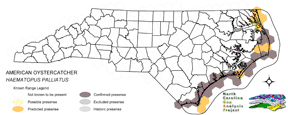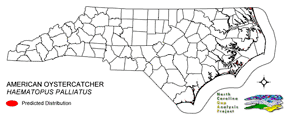
| Taxa: |
| Order: |
| Family: |
| Aves |
| Charadriiformes |
| Haematopodidae |
| NatureServe Global Rank: |
| NatureServe State (NC) Rank: |
| G5 |
| S4B,S4N |
| Federal Status: |
| NC State Status: |
| --- |
| --- |


| Land Unit |
| US Fish & Wildlife Service |
| US Forest Service |
| US National Park Service |
| US Department of Defense |
| NC State Parks |
| NC University System |
| NC Wildlife Res. Com. |
| NC Forest Service |
| NC Div. of Coastal Mgmt. |
| Local Governments |
| Non-Governmental Org. |
| Other Public Lands |
| Private Lands |
| GAP Status 1-2 |
| All Protected Lands |
| Statewide |
| Hectares |
| 11,410.74 |
| 181.89 |
| 6,986.61 |
| 9,331.02 |
| 1,739.61 |
| 0.00 |
| 3,207.87 |
| 0.00 |
| 1,610.28 |
| 2.52 |
| 1,985.22 |
| 34.65 |
| 49,890.69 |
| 23,902.56 |
| 35,948.34 |
| 86,381.10 |
| Acres |
| 28,196.55 |
| 449.46 |
| 17,264.29 |
| 23,057.45 |
| 4,298.67 |
| 0.00 |
| 7,926.82 |
| 0.00 |
| 3,979.09 |
| 6.23 |
| 4,905.58 |
| 85.62 |
| 123,282.56 |
| 59,064.50 |
| 88,830.27 |
| 213,452.31 |
| % of Dist. on |
| Prot. Lands |
| 31.7 % |
| 0.5 % |
| 17.9 % |
| 26.0 % |
| 4.8 % |
| 0.0 % |
| 8.9 % |
| 0.0 % |
| 4.5 % |
| 5.5 % |
| 5.5 % |
| < 0.1 % |
| 0.0 % |
| 66.5 % |
| ----- |
| ----- |
| % of Dist. on |
| All Lands |
| 13.2 % |
| 0.2 % |
| 8.1 % |
| 10.8 % |
| 2.0 % |
| 0.0 % |
| 3.7 % |
| 0.0 % |
| 1.9 % |
| < 0.1 % |
| 2.3 % |
| < 0.1 % |
| 57.8 % |
| 27.7 % |
| ----- |
| ----- |
|
Fairly common along the coast and barrier islands (Fussell 1994, Fussell and Lyons 1990). Strictly a coastal species (Hayman 1996). Lives near oyster beds or clam flats in areas with extensive sandy or rocky beaches, tidal mudflats, and salt marshes. Nests among sand dunes, on islands in a salt marsh, or on dredge spoil islands (Hayman et. al. 1986, Kaufman 1996). Nest is placed above the high water mark (Harrison 1975) in an open area among shells, gravel, and marsh grass on a sandy or gravelly substrate (Ehrlich et al. 1988). NATURE SERVE GLOBAL HABITAT COMMENTS: Rocky and sandy seacoasts and islands (AOU 1983); river mouths and estuaries, especially where rocks exposed at low tide; mudflats, salt ponds (Stiles and Skutch 1989). Nests on the ground in open sites often on high parts of sandy beaches, also among rocks, on islands, on shingle beds, occasionally in saltmarsh (Harrison 1979, Harrison 1978, Shields and Parnell 1990). In marsh habitats, nested on sand in North Carolina, on sand, wrack, or grass in New York and New Jersey (Lauro and Burger 1989). |
| Code | Name | Description | NC Natural Heritage Program Equivalent |
| 378 | Ocean Beaches | Open beach sand. | Upper Beach |
| 3 | Tidal Marsh | Fresh and brackish tidal marshes, including cord grass, wild rice, sawgrass and needlerush alliances. | Brackish Marsh, Interdune pond, Maritime wet grassland |
| 375 | Hypersaline coastal salt flats | Tidal flats within salt marshes, including saltmeadow cordgrass or sea-purslane dominated alliances. | Salt Marsh |
| 371 | Maritime Grasslands | Dune grass community consisting of sea oats and beach grasses. | Dune grass, Maritime dry grassland |
| 8 | Open water | Open water without aquatic vegetation. | No equivalent |
|
Shields, M. A., and J. F. Parnell. 1990. Marsh nesting by American oystercatchers in North Carolina. J. Field Ornithol. 61:431-433.
Bent, A.C. 1929. Life histories of North American shore birds. Part II. U.S. National Museum Bulletin No. 146. Washington, D.C. Fussell, J. III and M. Lyons. 1990. Birds of the Outer Banks [pamphlet]. Eastern National Parks and Monument Association Coastal Wildlife Refuge Society. Lauro, B., E. Nol, and M. Vicari. 1992. Nesting density and communal breeding in American oystercatchers. Condor 94:286-289. Fussell, J.O. III. 1994. A birderís guide to coastal North Carolina. Chapel Hill and London: The University of North Carolina Press. Kaufman K. 1996. Lives of North American Birds. Boston, New York: Houghton Mifflin Company. Lauro, B., and J. Burger. 1989. Nest-site selection of American oystercathers (HAEMATOPUS PALLIATUS) in salt marshes. Auk 106:185-192. Nol, E. 1989. Food supply and reproductive performance of the American oystercatcher in Virginia. Condor 91:429-435. Harrison, H.H. 1975. A field guide to bird's nests in the U.S. east of the Mississippi River. Houghton Mifflin Company, Boston, Massachusetts. 257 p. Harrison, C. 1978. A field guide to the nests, eggs and nestlings of North American birds. Collins, Cleveland, Ohio. Harrison, H.H. 1979. A field guide to western birds' nests. Houghton Mifflin Company, Boston. 279 pp. Terres, J.K. 1980. The Audubon Society encyclopedia of North American birds. Alfred A. Knopf, New York. American Ornithologists' Union (AOU), Committee on Classification and Nomenclature. 1983. Check-list of North American Birds. Sixth Edition. American Ornithologists' Union, Allen Press, Inc., Lawrence, Kansas. National Geographic Society (NGS). 1983. Field guide to the birds of North America. National Geographic Society, Washington, D.C. Raffaele, H.A. 1983. A guide to the birds of Puerto Rico and the Virgin Islands. Fondo Educativo Interamericano, San Juan, Puerto Rico. 255 pp. Jehl, J. R., Jr. 1984. Hybridization and evolution of oystercatchers on the Pacific Coast of Baja California. Ornithol. Monogr. 36:484-504. Hayman, P., J. Marchant and T. Prater. 1986. Shorebirds. An identification guide to the waders of the world. Boston: Houghton Mifflin Company. Ehrlich, P.R., D.S. Dobkin, and D. Wheye. 1988. The birder's handbook:a field guide to the natural history of North American birds. Simon and Shuster, Inc., New York. xxx + 785 pp. Stiles, F.G., and A.F. Skutch. 1989. A guide to the birds of Costa Rica. Comstock Publ. Associates, Cornell University Press, Ithaca, New York. 511 pp. |
For more information please contact them at:
NC-GAP Analysis Project
Dept. of Zoology, NCSU
Campus Box 7617
Raleigh, NC 27695-7617
(919) 513-2853
www.basic.ncsu.edu/ncgap